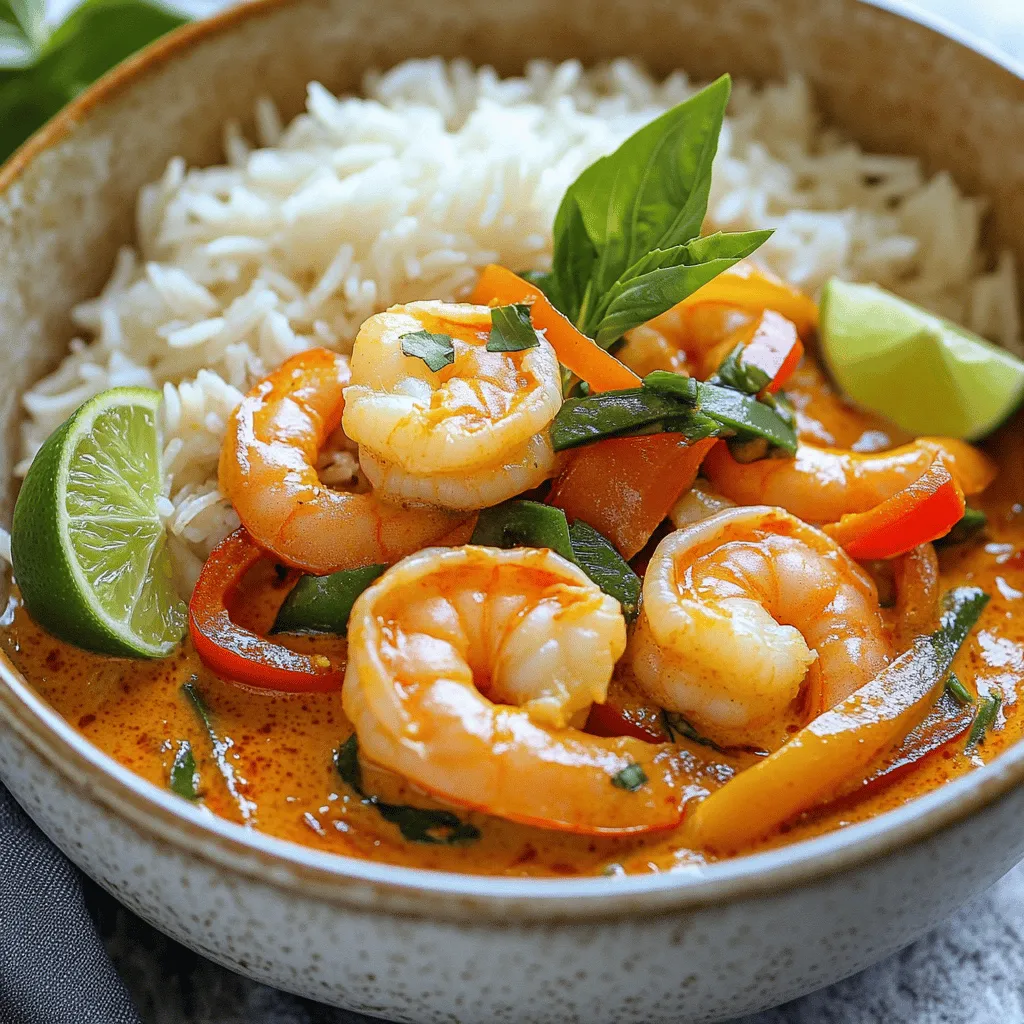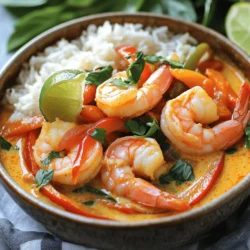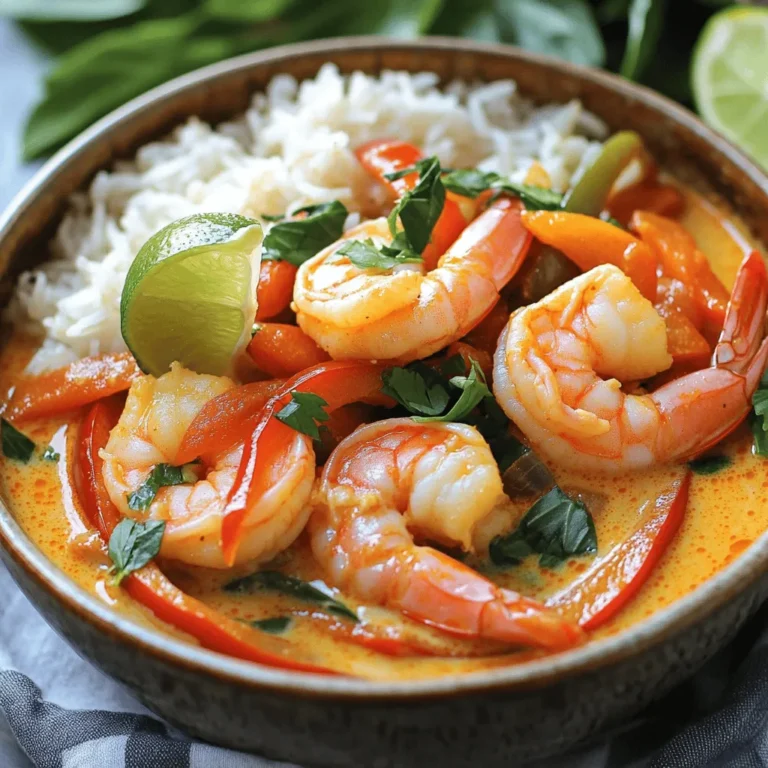If you crave a dish that bursts with flavor, you’re in the right place! Thai Coconut Shrimp Curry is simple to make and sure to impress. With juicy shrimp, creamy coconut milk, and aromatic red curry paste, this recipe packs a punch. Plus, you’ll find tips for customization, storage, and serving. Ready to dive in? Let’s create a meal that will leave everyone asking for seconds!
Ingredients
Main Ingredients
– 1 lb large shrimp, peeled and deveined
– 1 can coconut milk (13.5 oz)
– 2 tablespoons red curry paste
Vegetables
– 1 medium onion, chopped
– 1 bell pepper (red or yellow), sliced
– 2 cloves garlic, minced
– 1-inch piece ginger, grated
Seasoning and Garnishes
– 1 tablespoon fish sauce (or soy sauce for vegetarian)
– 1 tablespoon brown sugar
– Juice of 1 lime
– Fresh basil or cilantro for garnish
– Salt to taste
In this dish, large shrimp serve as the star. They add a lovely texture and soak up flavors well. The coconut milk makes the sauce creamy and rich. It balances the spice from the red curry paste, which gives the dish its bright color and depth.
Next, the vegetables bring life to the curry. Onions and bell peppers add sweetness and crunch. Garlic and ginger give it a fragrant touch that fills your kitchen with warmth.
Seasoning is key. Fish sauce or soy sauce adds umami goodness. Brown sugar brings a hint of sweetness, while lime juice adds brightness. Fresh herbs like basil or cilantro make the dish fresh and colorful.
All these ingredients come together in a simple yet flavorful way. They each play a role, making this curry a delight for the taste buds.
Step-by-Step Instructions
Preparing the Base
1. Heating the olive oil
Start by heating the olive oil in a large skillet or wok over medium heat. This step warms the oil so it can cook the vegetables well.
2. Sautéing vegetables
Next, add the chopped onion and bell pepper. Sauté them for about 3-4 minutes. You want them to soften but not brown. Stir them often to keep them from sticking.
Combining the Flavors
1. Adding garlic, ginger, and curry paste
After the veggies soften, stir in the minced garlic and grated ginger. Cook them for 1-2 minutes until you smell that great aroma. Then, add the red curry paste to the skillet. This gives your dish its rich flavor. Stir it well to mix everything.
2. Mixing in coconut milk and seasonings
Now, pour in the coconut milk. It will make the curry creamy. Then, stir in the fish sauce, brown sugar, and lime juice. Bring this mixture to a gentle simmer. This step helps all the flavors blend together nicely.
Cooking the Shrimp
1. Simmering the mixture
Once your mixture is simmering, it’s time to add the shrimp. Carefully place them in the skillet. They will cook quickly in the warm sauce.
2. Checking for doneness
Cook the shrimp for about 5-7 minutes. Stir occasionally until they turn pink and are fully cooked. Make sure not to overcook them, or they will become tough. Taste the curry and add salt if needed. Adjust the lime juice for a fresh flavor boost.
Tips & Tricks
Cooking Tips
To ensure shrimp are properly cooked, look for their color. They should turn pink and opaque. Overcooking can make them tough. Cook for about 5-7 minutes in the curry. Stir gently to avoid breaking them.
If you want to adjust the spiciness, start with a small amount of red curry paste. You can always add more later. Taste the curry while cooking. This way, you can find the right heat for you.
Serving Suggestions
For ideal rice pairings, jasmine rice works best. Its soft and fragrant texture complements the curry well. You can also try coconut rice for a tropical twist.
For plate presentation, serve the curry in deep bowls. Place a scoop of rice in the center. Then, ladle the curry around the rice. Garnish with fresh herbs and a lime wedge for color. This makes the dish look inviting.
Ingredient Substitutions
If you need alternatives for fish sauce, soy sauce is a great choice. It adds a salty flavor without the fish. You can also use tamari for a gluten-free option.
Using other types of curry paste can change the flavor. Green curry paste can add a fresh kick. Yellow curry paste offers a milder taste. Experiment to find what you like best!

Variations
Vegetarian Options
You can easily make this dish vegetarian. Swap the shrimp for tofu or your favorite vegetables. Tofu absorbs flavors well, which makes it a great choice. Use firm tofu and cut it into cubes. Sauté it until golden brown. You can also add veggies like bell peppers, broccoli, or snap peas for extra crunch. This way, you keep the creamy texture and bold taste.
Different Flavor Profiles
To change the flavor, think about adding lime leaves or different spices. Lime leaves give a fresh, zesty taste. You can also try adding Thai basil or lemongrass for a unique twist. Explore other Thai ingredients like tamarind or fish sauce substitutes. Soy sauce or coconut aminos work well if you want a vegetarian option. These small changes can make a big difference in taste.
Quick-Cooking Variants
If you’re short on time, use pre-cooked shrimp. This cuts down your cooking time significantly. Just add the shrimp at the end to heat them through. You can also make this a one-pot meal. Cook everything in a single pot, saving you from extra dishes. Begin by sautéing the veggies, then add the coconut milk and shrimp. This makes clean-up easy and keeps the flavors rich and mixed.
Storage Info
Refrigeration Guidelines
To store leftovers, let the curry cool first. Then, put it in an airtight container. This will keep it fresh. You can store it in the fridge for up to three days. The flavors will blend better with time, but don’t wait too long!
Freezing Instructions
To freeze the curry, use a freezer-safe container. Leave some space at the top, as the curry will expand. You can freeze it for up to three months. To thaw, place it in the fridge overnight. For quick thawing, use a microwave on low power.
Reheating Tips
When you reheat the curry, do it slowly on the stove. This helps keep the texture nice. Stir often to prevent sticking. If using the microwave, heat in short bursts, stirring in between. To avoid overcooking the shrimp, only heat until warm. This keeps them juicy and tender. Enjoy your meal!
FAQs
What kind of shrimp should I use?
You can use both fresh and frozen shrimp. Fresh shrimp tastes great but can be hard to find. Frozen shrimp are easy to get and are often just as good. When using frozen shrimp, thaw it before cooking. Look for large shrimp that are peeled and deveined. This saves time and makes prep easy.
Can I make this curry in advance?
Yes, you can make this curry in advance. Cook the curry and store it in the fridge. It lasts up to three days. When you’re ready to eat, reheat it on the stove. Add a splash of coconut milk to keep it creamy. You can also prep the ingredients ahead of time. Chop the veggies and store them in bags.
How do I make it spicier?
To make it spicier, you have a few options. Add more red curry paste for heat. You can also include fresh chili peppers or chili flakes. If you like it really hot, try Thai bird chilies. Start with a little and taste as you go. You can always add more heat, but it’s hard to take it out!
What can I serve with Thai Coconut Shrimp Curry?
This curry pairs well with jasmine rice. The rice soaks up the sauce and balances the flavors. You can also serve it with a side of steamed veggies. For drinks, a cold Thai iced tea or a light beer works well. Enjoy the meal with fresh herbs on top for extra flavor!
This post covered how to make a delicious Thai Coconut Shrimp Curry. We explored key ingredients like shrimp, coconut milk, and red curry paste. I shared tips for cooking, serving, and storing the dish. You can also find variations to suit your taste, such as vegetarian options and quick-cooking choices.
In conclusion, this curry is not just tasty; it’s easy to customize. You can enjoy it today or save it for later. Dive into this dish and enjoy every bite!

